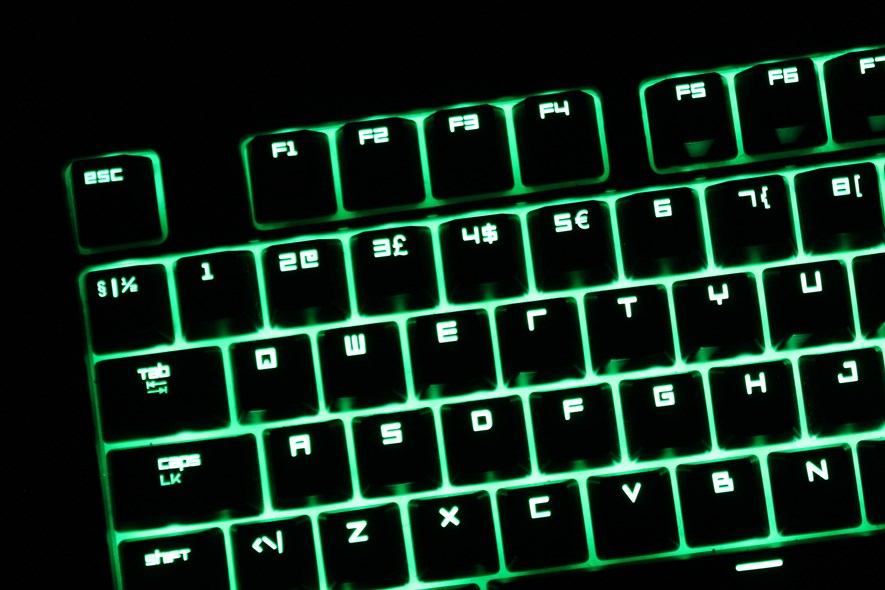
A year with the Razer Blackwidow Ultimate Stealth 2016 Edition
Mechanical yearly
Mechanical keyboards have been all the rage for quite some time now (since the 70s?). One year ago, wanting to jump on the bandwagon, I treated myself to one. This although my regular $12 keyboard was working just fine, that a mechanical keyboard is rather expensive, and that I wasn't even very fond of the tactile feel - or noise - of a mechanical keyboard. But as a programmer, I do type a lot, and good tools would hopefully help me in my line of work. How it went? Read on for more. (Spoiler: it turned out well!)
Picking the right keyboard... randomly
There wasn't much thought going into choosing this particular keyboard. I already had a mouse from Razer, and they have keyboards too, so I figured I could use the already installed and somewhat awful Razer synapse software. After seeing a couple of models in the shop, I went for the Blackwidow Ultimate Stealth 2016 Edition as the orange switches, similar to Cherry MX brown, were reasonably quiet and I didn't care for the macro buttons of the non-2016 model.

Initial impressions
After unboxing, I started wondering what I had gotten myself into. The thing was heavy as a brick. I was used to repositioning the keyboard on the desk every so often with a gentle push, which was impossible with the Razer. Instead, I needed to lift it using both hands. But enough of that, let's hook out up… with possibly the thickest and stiffest keyboard cable ever made. I found it interesting that Razer had integrated not only passthrough analog audio cables into the braided cord, but also a passthrough USB cable. A better solution could have been a USB hub, which would have enabled more than just one port. But my biggest gripe by far was the fact that Razer apparently forgot to label the USB connectors. As I had no use for the passthrough cable, I only wanted to connect the keyboard cable. But it doesn't say which one is which so it was trial and error. Super pro tip: mark the correct cable with a piece of tape for later!

Once properly hooked up, I played around with the very green lighting effect settings of the Razer Synapse software. And even though the novelty wears off quickly, the tool is quite flexible and it let me, for example, use dimmed light and then lighting up individual keys as they were pressed and slowly fading them out. Like fading footprints in the snow, except from fingers on plastic.

Months later...
One hope I had for this keyboard was that it would be easier on the fingers. Typing on a regular rubber dome keyboard requires each keypress to bottom out for it to register, but a mechanical keyboard of this type would register around halfway down. However, old habits die hard and I inadvertently kept bottoming out the keys. There is no dampening on the Razer, just cold, hard plastic - causing even more stress on the fingers. I got hold of a pack of clear o-ring keyboard dampeners, and after installing them, the problem went away. It definitely felt easier on the fingers, and the keyboard was much quieter, too.

A couple of months later, I connected my old keyboard to another computer and was typing a little. It felt awfully mushy. And I realized that my way to type had changed; I wasn't bottoming out the keys anymore so lots of my presses didn't register. Had I been using that thing for years? Back to the Razer…
Conclusion
There was a note in the box saying "Congratulations, there is no turning back". And after a year, I think I both understand and agree. So would I recommend the jump from a regular keyboard to a mechanical one? I would say yes. But it may take time to understand why. As a tldr, here are my pros and cons after a week of using it, and a year later:
Pros (after one week of usage):
- Keys feel different I guess??
Pros (after one year of usage):
- Great tactile feel with slight audible feedback
- Stays put on desk, doesn’t move around as you type
- Easy on the fingers
Cons (after one week of usage):
- Expensive (compared to a regular keyboard)
- Heavy
- Thick, stiff cable
- USB cables not labeled with what they do
- No adapter included for the combined audio jack - cannot connect the good ol' Steelseries Siberia V2 without one
- Different fonts used for ASCII and (many) non ASCII characters (Scandinavian/Nordic model)
- Razer Synapse is slow to start and always nags about updates
Cons (after one year of usage):
- OK, most previous negative points still stand, I just don't care so much anymore.
And in case you were wondering, no, I don’t really type faster or more accurately. But it feels better!

1 Comment
Subscribe to new comments by RSS